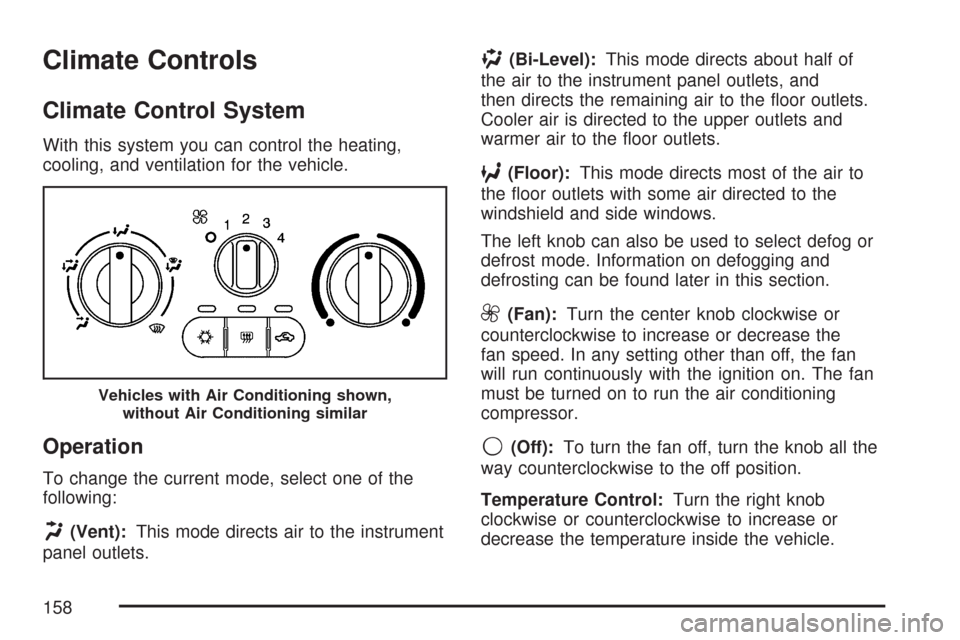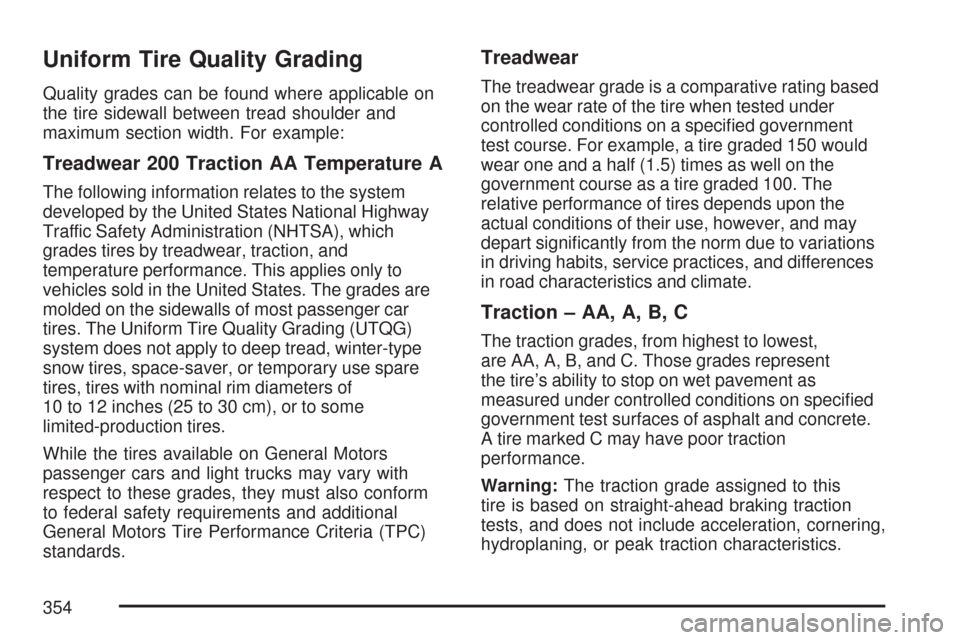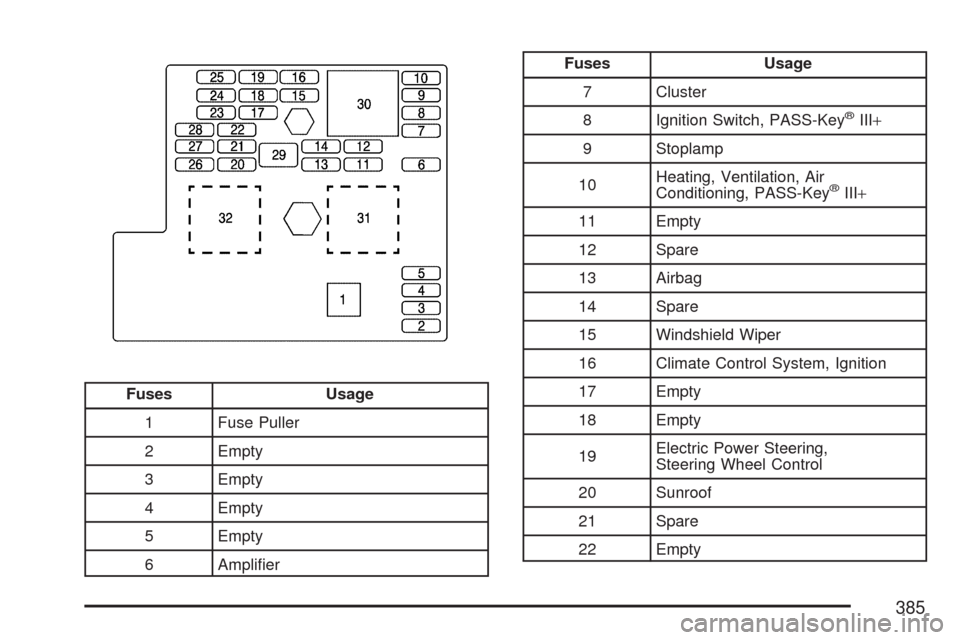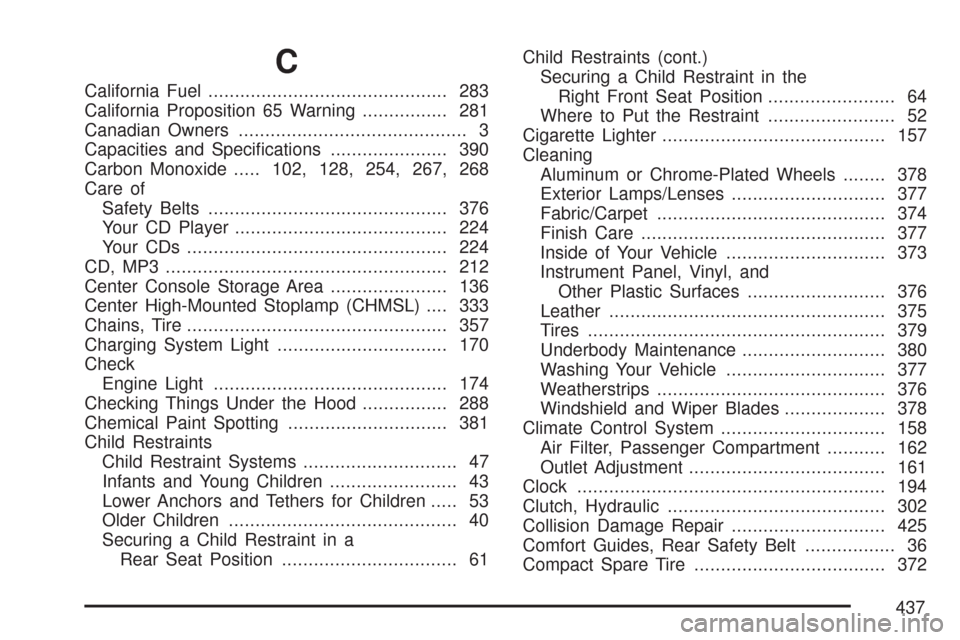climate control CHEVROLET COBALT 2007 1.G User Guide
[x] Cancel search | Manufacturer: CHEVROLET, Model Year: 2007, Model line: COBALT, Model: CHEVROLET COBALT 2007 1.GPages: 450, PDF Size: 2.48 MB
Page 158 of 450

Climate Controls
Climate Control System
With this system you can control the heating,
cooling, and ventilation for the vehicle.
Operation
To change the current mode, select one of the
following:
H(Vent):This mode directs air to the instrument
panel outlets.
)(Bi-Level):This mode directs about half of
the air to the instrument panel outlets, and
then directs the remaining air to the �oor outlets.
Cooler air is directed to the upper outlets and
warmer air to the �oor outlets.
6(Floor):This mode directs most of the air to
the �oor outlets with some air directed to the
windshield and side windows.
The left knob can also be used to select defog or
defrost mode. Information on defogging and
defrosting can be found later in this section.
9(Fan):Turn the center knob clockwise or
counterclockwise to increase or decrease the
fan speed. In any setting other than off, the fan
will run continuously with the ignition on. The fan
must be turned on to run the air conditioning
compressor.
9(Off):To turn the fan off, turn the knob all the
way counterclockwise to the off position.
Temperature Control:Turn the right knob
clockwise or counterclockwise to increase or
decrease the temperature inside the vehicle.
Vehicles with Air Conditioning shown,
without Air Conditioning similar
158
Page 160 of 450

Defogging and Defrosting
Fog on the inside of windows is a result of high
humidity (moisture) condensing on the cool window
glass. This can be minimized if the climate control
system is used properly. There are two modes to
clear fog or frost from the windshield and side
windows. Use the defog mode to clear the windows
of fog or moisture and warm the passengers. Use
the defrost mode to remove fog or frost from the
windshield more quickly. For best results, clear all
snow and ice from the windshield before defrosting.Turn the left knob to select the defog or
defrost mode.
-(Defog):This mode directs about half of
the air to the windshield and the side window
outlets and half to the �oor outlets. When
you select this mode the system runs the air
conditioning compressor. To defog the windows
faster, turn the temperature control knob clockwise
to the warmest setting.
0(Defrost):This mode directs most of the
air to the windshield, with some air directed to
the side window outlets and the �oor outlets.
When you select this mode the system runs
the air conditioning compressor. To defrost the
windows faster, turn the temperature control knob
clockwise to the warmest setting.
160
Page 354 of 450

Uniform Tire Quality Grading
Quality grades can be found where applicable on
the tire sidewall between tread shoulder and
maximum section width. For example:
Treadwear 200 Traction AA Temperature A
The following information relates to the system
developed by the United States National Highway
Traffic Safety Administration (NHTSA), which
grades tires by treadwear, traction, and
temperature performance. This applies only to
vehicles sold in the United States. The grades are
molded on the sidewalls of most passenger car
tires. The Uniform Tire Quality Grading (UTQG)
system does not apply to deep tread, winter-type
snow tires, space-saver, or temporary use spare
tires, tires with nominal rim diameters of
10 to 12 inches (25 to 30 cm), or to some
limited-production tires.
While the tires available on General Motors
passenger cars and light trucks may vary with
respect to these grades, they must also conform
to federal safety requirements and additional
General Motors Tire Performance Criteria (TPC)
standards.
Treadwear
The treadwear grade is a comparative rating based
on the wear rate of the tire when tested under
controlled conditions on a speci�ed government
test course. For example, a tire graded 150 would
wear one and a half (1.5) times as well on the
government course as a tire graded 100. The
relative performance of tires depends upon the
actual conditions of their use, however, and may
depart signi�cantly from the norm due to variations
in driving habits, service practices, and differences
in road characteristics and climate.
Traction – AA, A, B, C
The traction grades, from highest to lowest,
are AA, A, B, and C. Those grades represent
the tire’s ability to stop on wet pavement as
measured under controlled conditions on speci�ed
government test surfaces of asphalt and concrete.
A tire marked C may have poor traction
performance.
Warning:The traction grade assigned to this
tire is based on straight-ahead braking traction
tests, and does not include acceleration, cornering,
hydroplaning, or peak traction characteristics.
354
Page 385 of 450

Fuses Usage
1 Fuse Puller
2 Empty
3 Empty
4 Empty
5 Empty
6 Ampli�er
Fuses Usage
7 Cluster
8 Ignition Switch, PASS-Key
®III+
9 Stoplamp
10Heating, Ventilation, Air
Conditioning, PASS-Key
®III+
11 Empty
12 Spare
13 Airbag
14 Spare
15 Windshield Wiper
16 Climate Control System, Ignition
17 Empty
18 Empty
19Electric Power Steering,
Steering Wheel Control
20 Sunroof
21 Spare
22 Empty
385
Page 386 of 450

Fuses Usage
23 Audio System
24Sensing and Diagnostic Module
(Airbag)
25Engine Control Module,
Transaxle Control Module
26 Door Locks
27 Interior Lights
28 Steering Wheel Control Illumination
29 Power WindowsRelays Usage
30 Climate Control System
31 Empty
32 Retained Accessory Power (RAP)
Engine Compartment Fuse Block
The engine compartment fuse block is located on
the driver’s side of the vehicle. Lift off the cover
to check the fuses. SeeEngine Compartment
Overview on page 290for more information
on location.
386
Page 437 of 450

C
California Fuel............................................. 283
California Proposition 65 Warning................ 281
Canadian Owners........................................... 3
Capacities and Speci�cations...................... 390
Carbon Monoxide.....102, 128, 254, 267, 268
Care of
Safety Belts............................................. 376
Your CD Player........................................ 224
Your CDs ................................................. 224
CD, MP3 ..................................................... 212
Center Console Storage Area...................... 136
Center High-Mounted Stoplamp (CHMSL).... 333
Chains, Tire................................................. 357
Charging System Light................................ 170
Check
Engine Light............................................ 174
Checking Things Under the Hood................ 288
Chemical Paint Spotting.............................. 381
Child Restraints
Child Restraint Systems............................. 47
Infants and Young Children........................ 43
Lower Anchors and Tethers for Children..... 53
Older Children........................................... 40
Securing a Child Restraint in a
Rear Seat Position................................. 61Child Restraints (cont.)
Securing a Child Restraint in the
Right Front Seat Position........................ 64
Where to Put the Restraint........................ 52
Cigarette Lighter.......................................... 157
Cleaning
Aluminum or Chrome-Plated Wheels........ 378
Exterior Lamps/Lenses............................. 377
Fabric/Carpet........................................... 374
Finish Care.............................................. 377
Inside of Your Vehicle.............................. 373
Instrument Panel, Vinyl, and
Other Plastic Surfaces.......................... 376
Leather.................................................... 375
Tires........................................................ 379
Underbody Maintenance........................... 380
Washing Your Vehicle.............................. 377
Weatherstrips........................................... 376
Windshield and Wiper Blades................... 378
Climate Control System............................... 158
Air Filter, Passenger Compartment ........... 162
Outlet Adjustment..................................... 161
Clock.......................................................... 194
Clutch, Hydraulic......................................... 302
Collision Damage Repair............................. 425
Comfort Guides, Rear Safety Belt................. 36
Compact Spare Tire.................................... 372
437